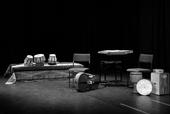Generate your own contact table!
Mahoott
In 2005, 4 musicians from 4 different cultures (Iranian, Indian, Taiwanese and German) gathered and devoted each one's talent, experiences and enthusiasm to a world music ensemble – Mahoott. Ever since then, those outstanding instrumentalists have been trying, by combining with their own cultural backgrounds, to make their sound image and the instrumentation of classical and traditional music variant.
Thus, every piece of Mahoott gets itself involved into a certain culture. Nevertheless, thanks to the Members' creativities, their music can also be a mixture of traditional and contemporary expressions. Besides, their knowledges and experiences are clearly seen in other areas like jazz, improvisation, pop and performance.
The instruments Mahoott plays with are not only a way to expand the traditional music territory but a bold try for a breakthrough. The sounds arranged by Mahoott are, due to the Members' unique understanding and precise feelings, characteristically quite distinctive.
Mahoott's musical pieces are partially original. But all of a sudden there come Indian sounds on the cello, Russian classical notes on the Persian santour, or a western styled cello solo in an ancient oriental melody – What a contrast! Just through these contrasts we can get a deep view of the features of the instruments, and also the music composed for them.
By Mahoott, joyfully fresh air is brought into the more serious classical music area. The in the air floating tones, whirling melodies, and sometimes ‚still' rhythms and stunning percussion solo are the means in which the group fascinates its audience.
Since its foundation in 2005, with the frequent appearance in numerous concerts, clubs and festivals, Mahoott has been being recognised as a significant world music ensemble.
Mahoott - An exciting and pleasant journey through time and space in the music world.
The instruments:
Santour
The santour is a hammered dulcimer of Iran. It is a trapezoid-shaped box often made of walnut, with 72 strings. The special-shaped mallets (merzrab) are lightweight and are held between the index and middle fingers. A typical santour has two sets of bridges, providing a range of three and a half octaves (27 tone all together). The right-hand strings are made of brass, while the left-hand strings are made of steel.
Tabla
The tabla is a popular Indian percussion instrument used in the classical, popular and religious music of the Indian subcontinent and in Hindustani classical music. The instrument consists of a pair of hand drums of contrasting sizes and timbres. The smaller one (Dayan) produces high tones while the bigger one (Bayan) deep tones and glissandi.
Cello
The cello is one typical bowed stringed instrument of the European music. But it can even be performed, extraordinarily, in non-European music as well with quarter tones and improvisation.
Tombak
The cup-shaped drum out of mulberry wood is the most important percussion instrument of the classical and traditional Persian music. It is covered with goat or lamb skin and is played horizontally with both hands and with a high degree of finger skill.
Riq
The riq is a type of tambourine used as a traditional instrument in Arabic music. It traditionally has a wooden frame, jingles, and a thin, translucent head made of fish skin.
Cajon
The cajon is a kind of box drum played by slapping its front face (generally thin plywood) with the hands.
Pandeiro
The pandeiro is a type of hand frame drum with jingles from Brazil.
Tar
The tar is a hand-held frame drum from North-Africa which looks similar to a tambourine but has no jingles.
